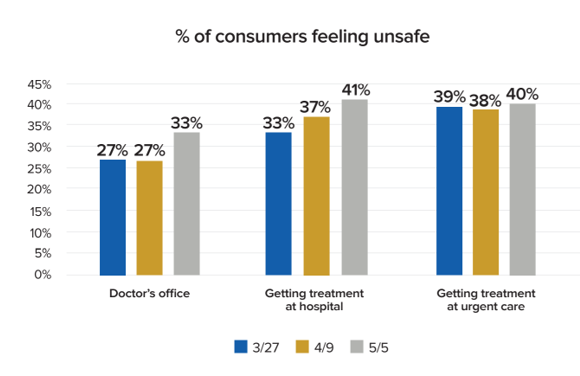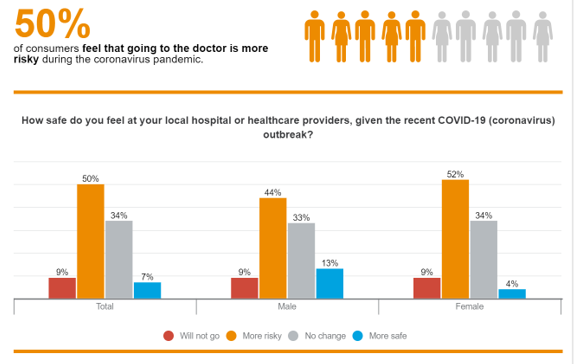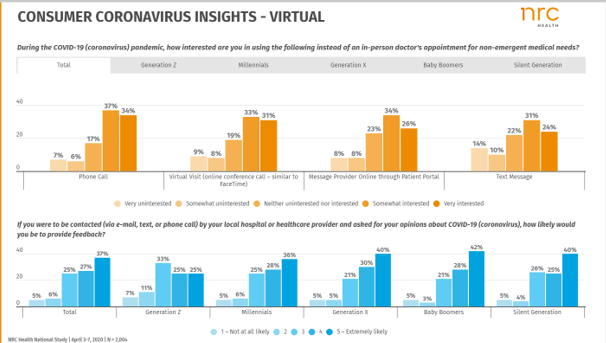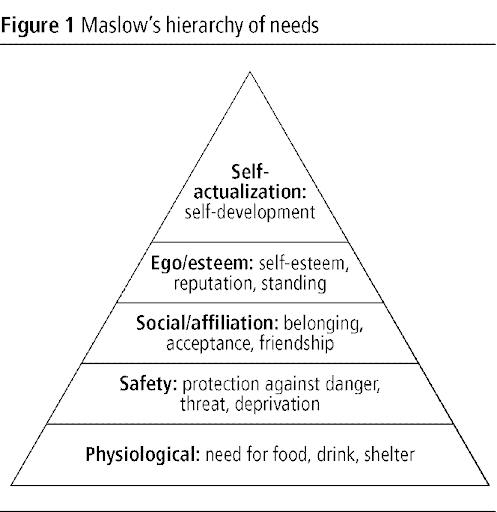 “We’re not getting back to business as usual any time soon,” Sage Growth Partners and Blackbook Research introduce their latest report on the COVID-19 pandemic, As the Country Reopens Safety Concerns Rise.
“We’re not getting back to business as usual any time soon,” Sage Growth Partners and Blackbook Research introduce their latest report on the COVID-19 pandemic, As the Country Reopens Safety Concerns Rise.
One of the areas that won’t be getting “back to business” soon will be patients’ visits to doctors’ offices, hospitals, and urgent care centers, the report notes, based on a survey conducted among 591 U.S. consumers on April 28 and 29, 2020.
Millions of U.S. health consumers’ feel unsafe, an increase among those who feel that way compared with SGP/Blackbook’s study from last month, a concern that ratcheted up six points for care at the doctor’s office, 4 points up for treatment at a hospital, and 2 points up for urgent care.
 Another study echoes these fear-findings: NRC asked consumers how safe they felt at their local hospital or health care providers given the COVID-19 outbreak, shown in the second chart.
Another study echoes these fear-findings: NRC asked consumers how safe they felt at their local hospital or health care providers given the COVID-19 outbreak, shown in the second chart.
In this poll, 1 in 2 consumers told NRC that they felt going to the doctor is more risky during the Coronavirus pandemic.
More women than men felt going to get health care at a doctor’s office or hospital was more risky in the pandemic: 52% of women compared with 44% of men. 9% of both men and women would not seek care at this time based on their unsafe feelings in the pandemic.
Consumers’ concerns in the NRC study also grew over time, from March into April, bolstering the SGP/Blackbook findings of greater anxiety about seeking health care in the pandemic.
The likelihood of seeking non-emergent care from a from a brick-and-mortar health care provider is more likely to happen three to six months from now (late April), based on the SGP/Blackbook data.
 Both the SGP/Blackbook and NRC surveys find growing health consumer interest in virtual care modes. The NRC study broke out four platforms:
Both the SGP/Blackbook and NRC surveys find growing health consumer interest in virtual care modes. The NRC study broke out four platforms:
- Phone call
- Virtual visit (telemedicine)
- Patient portal message, and
- Text messaging.
NRC Health asked 2,004 consumers in April 2020 about their interest in these four models of virtual care, finding that,
- 71% of people were interested in care via phone call
- 64% were interested in virtual visits
- 61% were interested in patient portal messaging, and
- 54% were keen on text messaging for care.
“The COVID-19 pandemic is reshaping the healthcare landscape and we likely won’t return to the way things used to be,” SGP/Blackbook concluded. Peoples’ growing acceptance and use of telehealth is an opportunity for providers to expand models of care delivery, they recommend.
 Health Populi’s Hot Points: These two studies, from SGP/Blackbook and NRC Health, bolster other research demonstrating, in real-time during the COVID-19 pandemic, that patients are growing health consumer muscles to assert more control over their health care. In this instance, our basic instinct for safety on the Maslow Hierarchy of Needs where safety is a universal human value: here shown as “protection against danger, threat, or deprivation.”
Health Populi’s Hot Points: These two studies, from SGP/Blackbook and NRC Health, bolster other research demonstrating, in real-time during the COVID-19 pandemic, that patients are growing health consumer muscles to assert more control over their health care. In this instance, our basic instinct for safety on the Maslow Hierarchy of Needs where safety is a universal human value: here shown as “protection against danger, threat, or deprivation.”
The last paragraph in the SGP/Blackbook report is provocative at this pandemic moment, looking less than six months out toward the U.S. Presidential elections.
“Change may also be coming for political leaders. People have lost confidence in how government leaders are handling the COVID-19 crisis and they may be taking a hard look at candidates on the federal, state, and local ballots come November,” the report finishes.
This insight dovetails with my concept of Health Citizenship which I detail in my book, HealthConsuming: From Health Consumer to Health Citizen.
In my own book’s conclusion, I assert that Americans must own their health, and not simply rent it.
The fast hockey-stick growth adoption of telehealth for self-care in the age of COVID is one signal that U.S. patients-as-payors and health consumers are engaging more in identifying and “consuming” health care services consistent with peoples’ values and sense of value. Digital platforms underpin our daily lives in the pandemic, where the home is our hub for work, for education, for food and nutrition, and for health, fitness and wellness. Telehealth, from the phone to the portal and Facetime visit with a doctor, is integrated into this new normal.




 Thanks to Feedspot for naming this blog, Health Populi, as a
Thanks to Feedspot for naming this blog, Health Populi, as a